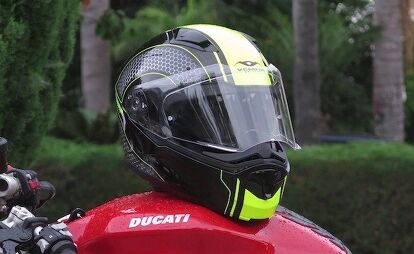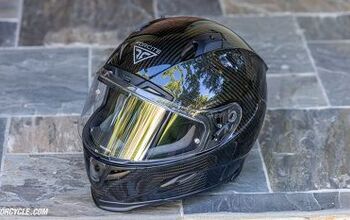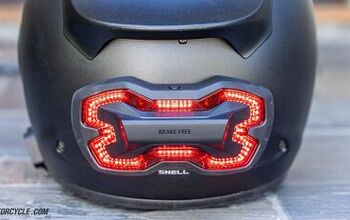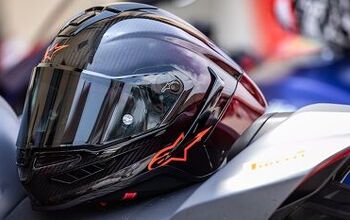MO Tested: Vemar Shark Modular Helmet Review
If you didn’t know the Vemar Shark was a $199 helmet, you probably wouldn’t guess it. You wouldn’t confuse it with our MO consensus Cadillac of modulars, the Shoei Neotec 2, but you also wouldn’t think it would sell for one- fourth the price of my go-to Neotec Splicer TC-6.
Vemar Shark modular helmet
| Aesthetics | 8.25/10 |
| Protection | 8.75/10 |
| Value | 9.5/10 |
| Comfort/Fit | 8.5/10 |
| Quality/Design | 8.0/10 |
| Weight | 8.0/10 |
| Options/Selection | 8.0/10 |
| Innovation | 8.0/10 |
| Weather Suitability | 8.0/10 |
| Desirable/Cool Factor | 8.0/10 |
| Overall Score | 83/100 |
Comfort is number one, and my head has been inside this reasonably plush size L Shark for three hours at a stretch with zero discomfort or hot spots, with no modifications whatsoever. The shell shape seems to be the same intermediate oval of the Shoei, which is so common among North American skulls. Naturally the Vemar’s insides are removable and washable, and the standard chin curtain and nicely padded neck roll keep the insides quiet and calm.
The mandible, or front of the helmet, locks into place with a reassuring snap, and unlike some (more expensive) modulars, the center-mounted release at the bottom of the chinbar is always easy to locate to open it again. One unique feature of the Vemar I really like is its really big storm trooper style eyeport. The eyeport’s not that tall, but it is really wide and extends lower than most at the sides; it’s like a bay window. Because of that, instead of reaching for the open-the-front button quick! at every stop, you sometimes forget you even have that option, since it feels so un-claustrophobic inside there. This one would make a good ADV helmet. Hang on while I see if goggles will fit. Yes, but just barely. (In fact, Vemar makes a couple of ADV helmets.)
The face shield mechanism seems a bit cheesy at first glance. There’s no cracked-open detent: Of the three detents, the first one has the shield open most of an inch. Weirdly enough, it’ll stay in that spot with little buffeting or weirdness up to well over 90 mph on a naked bike without slamming shut. And since it’s Pinlock ready, it feels like you might never miss the barely cracked anti-fog position found on more expensive lids. But I’ve only worn it in hot, dry conditions so far.
What’s really nice is that there are wings molded into the bottom of the shield on both sides, so it’s easy to open the shield with either hand (unlike my Neotec, whose shield can be a b***h to open sometimes, left thumb only) – and those same little wings seem to keep the shield positively closed when you’re rolling along at 80, even when you turn your head. The top of the shield has a unique molded profile also, that fits snugly onto the rubber trim on top of the eyeport. Overall, the thing’s remarkably quiet for a $200 modular helmet, and looks like it would keep out the rain, too.
Speaking of hot and dry, the chinbar vent is easy to find when you’re riding and flows a good amount of air when the shield is closed, and the two vents on top are also easy to operate while riding and flow good air (if not quite as much as the flow-through king Neotec).
Pushing down on the rear of the two top rocker-type vents opens them to let the air in. The exit vents are always open.
Yes, there’s a drop-down internal sun visor that deploys via a sliding bar at bottom left of the helmet, just like Neotec. We’ve grown to love these things for riding in bright sun followed by dark night, with no need to lug around an extra shield, and the Vemar’s works as well as any. Better than most in fact: Its visor’s got little winglets along its bottom edge too, and it seems quieter and calmer than most when riding with the main shield, or the front of the helmet, open.
There’s a removable port on the left side designed for a communicator to fit right over (and a sticky mount for a Cardo provided), pre-molded pockets in the EPS liner for speakers, and even a clip in the left front for a boom mike just like the one my Cardo Packtalk Bold came with. The speaker pockets molded into the EPS liner don’t line up with where my ears are, but that could be a defect with my head as much as with the Vemar?
Wire-framed eyeglasses slide in easily, my Wayfarers do too if a bit snuggly (they won’t go in my expensive Schuberth at all).
Paint and graphics aren’t up to Shoei/Arai standards, but again, not that far behind at all given the price difference. My favorite cheapie modular before this one was an HJC IS-MAX II; I’d say the made-in-China Vemar has the HJC beat in terms of design, fit/finish, appearance and comfort. It’s also less expensive. Weightwise, it feels a smidge heavier than the HJC, about the same as the Neotec 2. In addition to the Matt Black/Yellow here, there are also Matt Black/Orange and Matt Black/Gray color options, in six sizes from XS to XXL. My L fits my usual size L noggin just right.
This is my first Vemar, but it’s not Vemar’s first rodeo by any means. They’ve been at it since 1975 in Tuscany, Italy; you can read all about their history here. In addition to the mandatory DOT sticker, every Vemar helmet is engineered to Europe’s ECE-22.05 standard.
Even if you have an $800 head, I bet it would be about $400 to $500 as happy inside this great $200 helmet.
Vemar Shark – $199
More by John Burns





































Comments
Join the conversation